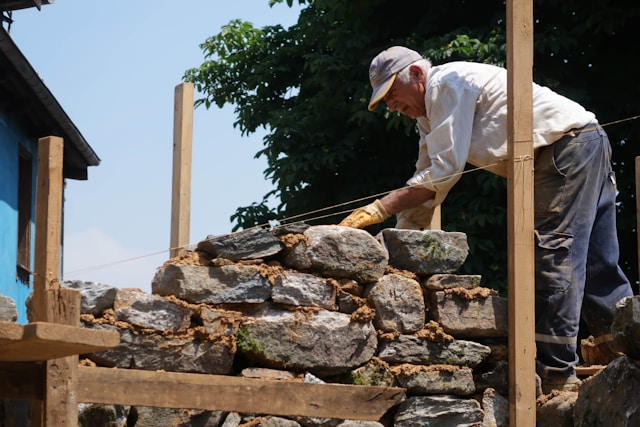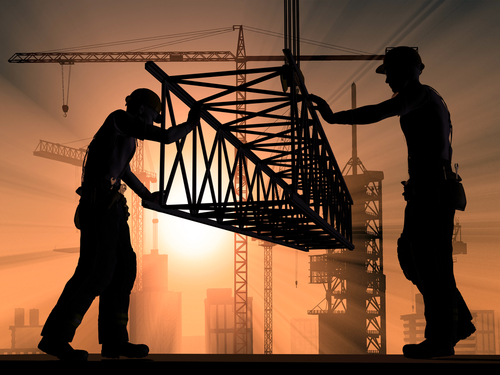Retaining walls are designed to hold back soil or earth, preventing erosion and creating level areas on sloping sites, thereby managing elevation changes, which is crucial for landscaping and construction projects. As such, they serve both functional and aesthetic purposes.

These walls are vertical structures designed to support soil laterally, retaining it at different levels on either side. By doing so, they prevent soil erosion, landslides and flooding while creating usable land space for gardens, patios, or even driveways. Retaining walls can be easily incorporated into garden landscaping to beautify the area whilst also being highly functional and allowing for expanded design concepts.
Retaining walls are used to eliminate soil erosion and improve drainage. If you have a wet foundation, notice places where water tends to pool, or if you want to level a sloped yard, they are the ideal solution to the problem. These walls are commonly constructed in areas with steep slopes or uneven terrain to create usable space and prevent land movement. By reinforcing soil and managing water drainage, retaining walls enhance both safety and functionality in landscapes.
Primary Functions of Retaining Walls
These versatile structures serve various purposes, namely:
- Soil Retention: A retaining wall’s primary function is to hold back soil and prevent erosion, making it essential in areas with steep slopes or uneven terrain. By providing lateral support, these structures help stabilise the soil behind them, ensuring long-term land integrity and safety.
- Slope Stabilisation: Natural landscapes are especially vulnerable to landslides during heavy rainfall or earthquakes. Retaining walls help stabilise slopes by absorbing and redistributing soil pressure, effectively reducing the risk of natural land movement.
- Water/Drainage Management: Retaining walls can play a pivotal role in water and drainage management. They help redirect water flow, preventing erosion and managing drainage. Some retaining walls are designed to be permeable, allowing water to seep through while effectively retaining the soil. They prevent water from flowing downhill and causing potential erosion issues.
- Creating Usable Space: In urban areas where land is at a premium, retaining walls can create level areas where gardens, outdoor living spaces, or even parking lots can be built. This optimises available space while ensuring both functionality and aesthetic appeal.
- Enhancing Aesthetics: Beyond their structural benefits, retaining walls can enhance a landscape’s visual appeal. With a variety of materials available, including stone, concrete, brick and wood, they can be designed to blend seamlessly with the surroundings, adding character and charm to both residential and commercial properties.
- Creating Level Spaces: They enable the creation of level planting areas, patios, or other functional spaces on slopes that would otherwise be unusable.
- Landscape Support: Retaining walls provide structural support for landscaping features, helping to maintain the integrity of slopes and preventing soil from washing away.
- Defining Outdoor Areas: They can be used to define outdoor living areas, creating distinct zones within a landscape.
- Infrastructure Support: Retaining walls can also be used to support infrastructure, such as roads or terraces, on sloping terrain.
- Safety and Stability: Retaining walls are crucial for safety and stability, especially in areas with steep slopes or where there is a risk of landslides or collapses.
- Versatile Applications: They can be used in various settings, from residential gardens to commercial properties and construction projects.
Types of Retaining Walls
Retaining walls are constructed from a variety of materials which are specific to their uses. Each has unique construction methods and applications.
The main types are:
- Gravity Retaining Walls: These rely on their own weight and mass to resist the pressure of the soil behind them, preventing toppling and sliding, and are suitable for shorter walls. They are constructed from heavy materials like concrete, stone, brick, or gabions. These walls are typically made of heavy materials like concrete, stone, or masonry blocks, and are often wider at the base than at the top. In their simplest form, gravity walls require no additional support.
- Embedded Retaining Walls: Embedded retaining walls are designed to prevent soil from collapsing into excavations or retaining cuts, which are common in infrastructure projects like tunnels and deep foundations. They include Cantilever walls, Anchored walls, and Propped walls.
- Cantilever Retaining Walls: Made from reinforced concrete, cantilever walls use leverage to hold back soil, making them suitable for taller structures. Their design minimises the amount of material needed while maintaining strength. They use an inverted “T” design with a stem, base slab, and heel slab for moderate to high walls, relying on leverage to retain soil. The vertical stem supports the weight of the soil, while the horizontal base helps distribute the pressure on the ground, making them a more efficient option than gravity walls. These walls are economical for retaining heights up to about 8 meters and take up less space than other types of retaining walls. They are suitable for residential and commercial applications. They can be constructed as either temporary or permanent structures.
- Anchored Retaining Walls: These walls are secured with cables or rods buried deep in the soil, providing additional support against lateral forces. They are particularly useful in high-stress applications and on steep slopes. The walls are supported by anchors driven into the earth behind them, which transfer the load to the soil mass behind the wall, allowing for thinner walls or higher loads. This additional support helps resist the forces acting on the wall, making them suitable for taller structures.
- Propped retaining Walls: These walls use temporary or permanent internal props such as struts or floor slabs to resist lateral earth pressure, offering stability and potentially reducing the need for deep excavation as compared to freestanding walls.
- Sheet Pile Retaining Walls: This type involves driving sheets of interlocking steel, timber, concrete or vinyl (piles) into the ground to provide stability and create a barrier against the soil. They are often used in soft soil conditions and are commonly seen in waterfront applications. They are used for temporary earth retention or in areas with irregular geological conditions. Ideal for narrow spaces, they hardly take up any room while providing substantial lateral support.
- Segmental Retaining Wall (SRW) Blocks: These walls are built with interlocking blocks, which are chosen for their straightforward installation and adaptability, allowing for the creation of curves and steps. These walls use gravity and friction to hold the blocks in place. Segmental retaining wall units, made from concrete masonry, provide the essential mass for structural stability while enhancing the wall’s durability and visual appeal. This flexibility allows for creative landscaping but requires careful planning to ensure stability.
- Gabion Walls: These are constructed using wire mesh containers filled with rocks or stones, offering a cost-effective and visually appealing solution.
- Crib Retaining Walls: Crib retaining walls are a type of gravity retaining wall constructed using interlocking box-like frameworks (cribs), often made of timber, concrete, polymers, or steel filled with soil or rock, used for soil stabilisation and erosion control. They are a specific type of gravity retaining wall, meaning they rely on their weight and mass to resist the forces of the soil they are holding back. They are filled with granular materials for drainage.
- Brick Retaining Walls: Grouted cavity retaining walls consist of two single skins of brickwork separated by a cavity which usually contains reinforcement. The cavity is either filled with concrete as the work proceeds or is filled in suitable batches when the brick skins have achieved sufficient strength. These walls are visually appealing and can be durable, offering a variety of design and brick pattern options.
- Counterfort Retaining Walls: A counterfort retaining wall is a type of retaining wall that uses vertical concrete webs, called counterforts, to resist lateral soil pressure, enhancing stability and reducing bending moments compared to traditional cantilever walls, especially for taller structures. These walls consist of a vertical wall (stem) and a base slab, with counterforts (vertical concrete webs) extending from the base to the stem on the soil-retaining side.
- Reinforced Earth Retaining Walls: A reinforced earth retaining wall, also known as a Mechanically Stabilised Earth (MSE) wall, uses layers of backfill and soil reinforcement elements connected to a wall facing to stabilise earth masses and create vertical or near-vertical faces. The core concept involves using soil reinforcement (like geogrids or steel strips) to increase the tensile strength of the soil mass, allowing it to withstand lateral earth pressures and support the wall structure. These elements are typically attached to a modular facing system (concrete blocks, panels, or wire mesh) that forms the visible face of the wall.
- Timber Retaining Walls: These can be constructed using various types of timber, such as treated pine or hardwood, offering a natural look and relatively quick installation. However, using plastic sheeting behind the wall to protect the wood could cause water build-up and possible wall damage and is therefore strongly discouraged.
Why Hire a Professional Retaining Wall Builder?
Retaining wall builders specialise in designing, constructing, and maintaining structures that prevent soil erosion and stabilise slopes. They work with a range of materials, including concrete blocks, natural stone, timber, and brick to create durable walls that not only withstand environmental pressures but also enhance the surrounding landscape. Whether managing a residential, commercial, or municipal project, employing the skills of the right retaining wall builders is crucial to ensuring durability, safety, and visual appeal.
They also provide several key benefits, including:
- Longevity: Walls built by professionals are designed for strength and durability, minimising the need for regular maintenance over time.
- Aesthetic Appeal: Experienced builders can create walls that not only enhance the landscape but also increase property value.
- Safety and Stability: Expertly constructed walls effectively prevent soil movement and minimise potential hazards.
- Compliance: Professionals ensure that the wall complies with all relevant legal and engineering standards.
Building and Construction Considerations
When building a retaining wall, certain factors need to be considered to ensure structural integrity and functionality:
- Purpose: Determine the main objective of the wall. Is it mainly to manage water, add usable space, or enhance the aesthetic appeal of your landscape?
- Soil Type: Understanding the soil condition on your property will help you choose the right design and materials. Sandy soils, for instance, drain water quickly but may not hold up in a gravity wall without proper drainage systems.
- Drainage: Poor drainage can lead to hydrostatic pressure, causing the wall to fail. Incorporating drainage systems, such as weep holes or gravel backfill, is essential for maintaining the wall’s durability.
- Height and Scale: Taller walls require deeper foundations and potentially additional support, while shorter walls might not need as much reinforcement.
- Environmental Considerations: Consider factors such as weather resistance, maintenance needs, and environmental impact.
- Engineering and Design: Retaining walls must be structurally sound, particularly for large or load-bearing walls. Builders should work with engineers when necessary to ensure compliance with safety regulations. Proper drainage systems should be incorporated to prevent water buildup and structural failure.
- Permits and Regulations: Some retaining walls require permits, depending on height and location.
Benefits of Retaining Walls
- Erosion Control: By stabilising soil, retaining walls minimise the risk of erosion, particularly in sloped areas.
- Increased Usable Space: Retaining walls enable the creation of flat areas in hilly landscapes, providing more space for gardening, play areas, or patios.
- Improved Aesthetics: With their versatile designs and materials, retaining walls can enhance the visual appeal of a landscape, serving as a stylish feature.
- Flood Management: They can help redirect water runoff and prevent flooding by managing groundwater flow and surface water.
- Property Value: A well-designed and constructed retaining wall can increase a property’s overall value, making it an attractive long-term investment for homeowners.
Conclusion
Retaining walls are more than just functional barriers – they are a valuable investment in land management, stability, and aesthetics. These structures play a vital role in preventing erosion and managing slopes while simultaneously enhancing the functionality and beauty of outdoor spaces. Consulting with professionals ensures proper design, safe construction, and compliance with local regulations. By appointing an experienced and knowledgeable retaining wall builder, the success of any project is significantly increased, ensuring durability and visual appeal for years to come.

